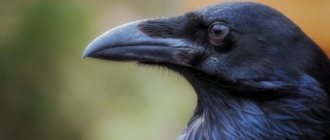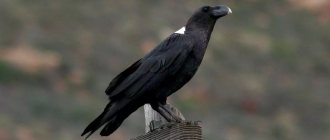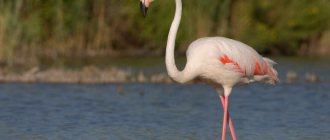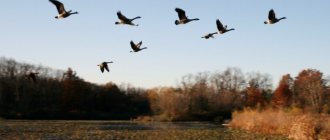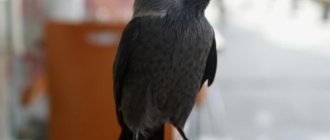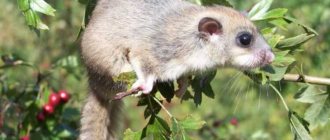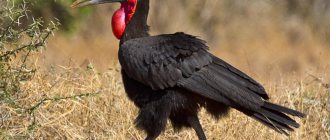Species and man
Being an omnivorous bird, the raven is now, as a rule, quite closely associated with humans (although it prefers to nest away from them). Throughout the year, crows often feed in city landfills and man-made waste sites. There they find food in abundance. And, having such an excellent food supply, crows are forced to tolerate the close presence of humans and can even settle on the outskirts of large cities.
Young crows are well tamed, but even after living for a long time in captivity, they remain quite independent. Adult birds are tamed with great difficulty or not at all. Tame crows are often taught to pull out various lottery tickets and all sorts of papers with predictions, which they perform with enviable dexterity and ease.
In the Tower of London, tame crows and special caretakers have long lived on government support. There is a legend that as long as ravens live in the Tower, Great Britain will exist. So for the British, the presence of ravens is “a matter of life and death.”
The appearance of the raven (large and black), his rough voice, behavior and feeding nature (scavenger) led to him being a hero (most often negative) of mythology, folklore, fiction, music, and painting. Most often in myths and tales, the raven is associated with evil and death. He flies to the scene of bloodshed and pecks out the eyes of the dead soldiers. In Scandinavian myths, ravens foretell the death of heroes. In Russian fairy tales, crows are also usually associated with evil spirits (Baba Yaga) and death. One of our darkest proverbs is also associated with not the best ideas about crows (and people): “A raven will not peck out a crow’s eye.” However, there is also a positive image of the raven, as a wise, strong and courageous bird. In the ancient Eastern tale of Gilgamesh, only the raven released from Noah's Ark was able to fly to the land that was freed after the global flood. The image of a raven is also reflected in fiction. Thus, the famous poem by the American poet Edgar Poe is called “The Raven.” The Russian writer I. A. Bunin has a story with this title. In heraldry, the raven is a symbol of foresight and longevity, and its images are found in the coats of arms of both individual noble families and families, as well as cities and entire regions.
What does it eat?
Raven eats cookies
Ravens have a varied diet. The bird is considered a predator, but most often prefers the carrion of large animals, and can also eat the bodies of fish and frogs. The raven is able to adapt to living conditions, even if the food supply is unstable. He eats everything he can find. In addition, the bird can behave like a real predator, chasing hares, rodents and other birds from the air.
Interesting: Animals - species, list, names, description, where they live, photos and videos
A raven will also happily eat a worm, insect or sea creature. Sometimes it eats seeds and fruits of plants. Packs can launch entire raids on farms. He does not deny himself the pleasure of eating what people throw in a landfill.
Distribution and habitats
The raven's range is very extensive, it is distributed in Eurasia (including Greenland), North America and North Africa from the Arctic coasts to the subtropics and the northern border of the tropics. It rises in the mountains to 5000–8000 m. In Russia it is absent only on the northernmost peninsulas (Yamal, Taimyr, Gydansky) and on most Arctic islands. Ecologically, the raven is very flexible; it can live in a wide variety of landscapes: forests, deserts, mountains. There are 9 subspecies of raven, which differ mainly in size. On the territory of Eurasia, sizes increase from west to east, i.e., crows living in Siberia are larger than their counterparts from Spain.
What is the difference between a raven and a crow
Raven and crow
Crow is not a word form denoting a female, but a completely different species. Birds differ in external characteristics, behavior, and lifestyle.
- the mass of a raven can reach up to 2 kg, while that of a crow is in the range of 1.2 kg;
- the first is black in color, and the second is dark gray;
- The crow's beak is short and cone-shaped, while the raven's is large and curved;
- a black bird soars during flight, makes rare wing beats, and a crow makes frequent ones;
- the raven can live up to 40 years, and the second only up to 10;
- The crow looks for a new mate every season, and the raven is monogamous.
And one more important difference: a crow feels less comfortable on city streets than a crow.
Appearance
The raven is the largest representative of the passerine order. Its body length is 60–65 cm, wing length is 43–44 cm, the weight of males is 1.1-!.5 kg, females - 0.8-1.3 kg, wingspan - 1.4-!.5 m.
The plumage is black with a bluish, greenish or violet metallic tint. The beak is sharp and strong, black in color. On the throat there is a “beard” of elongated feathers. The iris of the eyes is dark brown. The tail is wedge-shaped, which is clearly visible in a flying bird. Sexual dimorphism is expressed only in size, males are slightly larger than females. The color of young birds is also black, but matte, without a metallic sheen.
The largest raven in the world
The largest crows include the giant variety - Corvus fuscicapillus.
Description
The bird grows from 53 to 58 cm, the feathers have a blackish-purple tint, the belly and chest are brownish-blackish. There is a snow-white base on the body and head, the legs are the main color.
The large and curved beak is located high, allows you to determine gender:
- in the male it is uniformly dark;
- in the female it is orange-reddish, the tip is brownish.
Important! The iris of the bird's eyes is blue; the beak color of young males is lighter than that of females.
Where does it live?
Initially, giant crows settled in tropical and subtropical areas. In addition to forests, they can be seen in mangroves. The bird does not like open places, sea or remote islands; it can settle on a hill (1.4 thousand m high) or in a lowland.
Representatives are classified as endemic to Indonesia, where scattered bird populations are located over vast areas. Science has not been able to determine the principle of choosing a permanent place of residence. Experts indicate common habitat areas:
- the islands of West Papua, Aru and Gemien;
- a tributary of the Nimbokrang and Mamberano rivers;
- northern part of Papua.
Important! The small number of representatives is associated with the gradual disappearance of the natural habitat. Today the bird is classified as endangered.
Corvus fuscicapillus
Lifestyle, social structure and social behavior.
The raven is a very cautious bird; it usually doesn’t let anyone get close to it. The beautiful, free flight of a raven is more similar to the flight of a bird of prey than to the flight of other corvids; the bird can soar for a long time, and also perform complex figures in the air, especially during paired air currents. During fast flight, the feathers emit a characteristic ringing sound. The raven moves well on the ground, and before taking off, it makes several jumps on the ground, as if running.
The behavior of ravens in nature (during nesting, feeding) is so complex, unpredictable and sometimes inexplicable from our human point of view that scientists are forced to admit that ravens have a certain intelligence. The interaction of ravens with each other, with other birds, and with humans shows that these birds can solve quite complex life problems, learn throughout their lives, and perfectly adapt to rapidly changing environmental conditions.
Throughout almost the entire territory of their range, crows lead a sedentary lifestyle; only in years of significant food shortage can they migrate from their nesting sites. However, young crows are characterized by significant flight. They roam in groups of 3–7 individuals and move considerable distances. Banding of young crows in the European part of their range showed that they move 50–200 km from the place where they hatched from the egg.
Crows are active during the day, when they go in search of food. It can be considered that the raven occupies the ecological niche of large birds of prey: like them, the raven nests in separate permanent pairs (no closer than 1 km from each other), has a large hunting territory, builds massive nests high in trees or rocks, feeds on carrion or actively hunts .
Raven: description of the bird
In 1758, this bird was first described by naturalist Karl Lineus. Experts today identify 11 subspecies of raven, and the differences between the subspecies are so minimal that they have nothing to do with genetic characteristics, but are more determined by living conditions.
Raven presents:
- Animal Kingdom.
- Type – chordates.
- Class - birds.
- The order is passeriformes.
- Family – corvids.
- Genus - crows.
- Species: common raven.
The closest relatives of the raven include the American white-necked crow, the piebald raven and the desert brown-headed raven. Moreover, the last relative has great similarities with the rook.
Appearance
The raven represents the largest representative of the passerines. It grows up to 70 cm in length, with a wingspan of about 1.5 meters. The weight of the bird can be a maximum of one and a half kilograms, although there are individuals weighing up to 2 kilograms. The length and weight of the bird depends on the environmental conditions. Individuals inhabiting cold regions are large in size. Taking this factor into account, the largest individuals are found either in the mountains or in northern latitudes.
Interesting fact! The crow produces a fairly massive beak, as well as feathers that fan out on the bird’s throat. When a bird is in flight, it is not difficult to identify it by the wedge-shaped tail.
As a rule, males are larger than females, although it is almost impossible to distinguish them by color: both males and females are almost black in color, with a metallic tint. If you look from above, the bird has a blue tint, and if from below, it is green. Juveniles are distinguished by matte but black plumage. The bird has powerful legs armed with large, curved claws of the same black color. As a rule, the bird uses both its beak and claws to protect itself or attack enemies.
Lifestyle and intelligence
The common raven prefers forest spaces, dominated by plantings of old coniferous trees, in contrast to the urban gray raven. It prefers to stay in pairs, but with the arrival of autumn it forms small flocks consisting of 2 dozen individuals. This happens when the bird is preparing to make a long flight in search of food. Throughout the day, the raven is busy looking for food for itself, and in the evening it moves to its nest. While in a flock, crows are able to attack other flocks of their relatives in order to occupy their territory.
Interesting information! As a rule, the raven nests in forests, but with the arrival of real cold weather it prefers to move closer to people, to city dumps or cemeteries. Here they have a much better chance of finding food for themselves, especially during such a harsh period.
It should be noted that the raven is a smart bird. It has the same ratio of brain mass to body mass as a chimpanzee. According to scientists, the raven has intelligence. To confirm these assumptions, scientists conducted a lot of experiments so that the bird could reveal its mental abilities. One of the experiments was a repetition of Aesop's fable "The Crow and the Jug". The birds were placed in conditions where there were a lot of pebbles and a narrow vessel with worms, which were in a small amount of water.
The task for the birds was made more difficult by the fact that they could not easily get to food, so they had to rely on their intelligence. Oddly enough, the crows began to throw pebbles into the vessel, which began to raise the water level, and the worms began to rise along with the water. The experiment had to be repeated 4 times with new wards and each time the result was the same. In any case, the birds made a smart move, choosing larger rocks each time, as if they knew they would displace more water.
But experts didn’t stop there and began to study the crow’s language, because they thought that croaking had nothing to do with the random production of sounds. They came to the conclusion that birds talk like this, and not so primitively. Of course, it’s simply too much to call it the language of ravens, but they have something similar to the dialects that are associated with their habitats. The fact that these birds are real intellectuals can be judged by the presence of memory, which is passed on from generation to generation.
If a farmer kills just one bird from a flock of ravens, the entire flock may leave the area. The pack will remember the offender and will never return to the same place. A number of other experiments were carried out in which birds were offered opaque pipes with holes, and food was placed in the pipes.
As a result, the crows accurately found food and then the pipes were replaced with transparent ones. The birds had to get the food in the same way, without trying to break through the glass with their beaks. They coped with this task one hundred percent. Such self-control allows the bird to protect itself from any danger, remaining motionless for hours in search of food.
Talking Raven Carlos
How long do crows live?
There is no clear answer to this question, since habitat has a decisive influence on this indicator. Crows that live in urban areas and crows that live in the wild are two different birds and the number of years they live will be noticeably different.
Interesting to know! The longer a raven lives, the smarter and wiser it becomes, absorbing knowledge, skills and experience like a sponge.
Birds living within large cities, where the ecological situation is better, live no more than 10 years, although under certain conditions, given the fact that in the city the bird has practically no natural enemies, there are quite old individuals that have lived up to 30 years. In natural conditions, a raven lives for at least 15 years, although some individuals live up to 40. But even here, not all is well, since the birds have to get their own food every day. At the same time, crows are exposed to constant danger in the form of attacks from natural enemies. In addition, in the event of a bad year and a too cold winter, the entire flock may die.
According to the Arabs, the raven is an immortal bird. According to ancient records, a raven can live for at least 300 years. At the same time, folk epics say that a raven lives up to 9 human lives. Experts are skeptical about this category of rumors. At the same time, they believe that, under favorable conditions, a raven is capable of living one human life.
Crow and Raven: What's the Difference?
Many people, out of ignorance, believe that a crow is a female of the same species, and a raven is a male. In fact, they represent the same family, but belong to different species. Foreigners confuse these birds, but only because they have external similarities.
It is important to know! Crows prefer to settle near humans, unlike ravens, because in such conditions it is easier to get food. In our territories there is a hooded crow, which differs in the color of its body.
The black crow, which has an external resemblance to a raven even in body color, is more common in Western Europe, as well as in the East of Eurasia. In size, the carrion crow is inferior to the raven, since the birds weigh about 700 grams, with a body length of within 0.5 meters. There are other, smaller differences. The crow has no feathering on its crop, and in flight you can notice that its tail has a smooth rounding, while that of the raven has a wedge-shaped shape.
Crows generally gather in groups, and a single raven or a pair may be found. These birds can also be distinguished by hearing. The raven makes deep sounds that sound like "kaw" or "arra", and the crow makes nasal sounds that sound short "ka". These two species never live side by side, so a flock of crows often attacks a lone raven.
Natural habitats
The raven prefers to settle throughout the Northern Hemisphere, so it is found in North America, from Alaska to Mexico. In almost all European countries, with the exception of France, including in Asia and North Africa. For its nests it chooses places located near the sea, in deserts, and also in the mountains. The raven's favorite habitats are dense, ancient forests with a predominance of spruce trees. You can often see this unique bird in public gardens and city parks.
The northern part of Eurasia is almost completely populated, with the exception of Taimyr, Yamal and Gadyn, as well as the islands located in the Arctic Ocean. The southern borders of Eurasia are populated along the lines of Syria, Iraq, Iran, Pakistan, the Northern states of India, China and the Russian coastal region. The European habitat has shifted somewhat towards Western and Central Europe, although even here it is quite rare. Recently, the raven has become a rarity in North America, especially its central part. But the raven chose for itself places located on the border with Canada, in Minnesota, Wisconsin, Michigan and Maine.
There was a time when ravens inhabited New England, the Addirondack Mountains, the Alleghenies, including the coast of Virginia, as well as New Jersey and the Great Plains. The raven had to leave these places because they began to actively exterminate bison and wolves, the fallen individuals of which were included in the diet of this bird. The raven does not like to settle in big cities, although individual individuals have been seen in the parks of San Diego, Los Angeles, San Francisco, Riverside, as well as in the capital of Mongolia, Ulaanbaatar.
At the end of the 20th century it appeared in the northwestern regions of Russia. The raven does not like to settle next to a person, since this causes unnecessary anxiety for him, as well as the inability to find suitable places, in conditions of fierce competition among birds.
DO NOT HAVE CORAVE BIRDS!!! Don't have any corvids!
Diet
The diet of ravens is very varied. Although they are carnivores by nature, their main diet consists of the carrion of large animals such as deer and wolves. At the same time, the raven can eat dead fish, rodents and frogs for a long time. The raven has perfectly adapted to living conditions when the food supply is not abundant. At the same time, it feeds on everything it can catch or detect. He can hover in the air for a long time, like a real predator, looking for potential prey on the ground, in the form of a small hare, rodents, lizards, snakes or birds.
The raven happily feeds on various insects, mollusks, worms, sea urchins or scorpions. If it gets in the way, a raven will easily destroy someone else's nest. It also feeds on seeds of various plants, grains and fruits, so it often makes “raids” on farmland. On occasion, a raven may feast on eggs or young chicks. He also does not refuse leftover food that people throw into landfills. Therefore, whole flocks of birds can be seen in city landfills.
Interesting fact! If there is an abundance of food, the raven may hide the leftovers for later or may share these leftovers with its relatives. While hunting, a raven can watch for a long time and carefully how another predator hunts, knowing at the same time that he will get something or he will steal something that this hunter has hidden for later.
American experts monitored birds in Oregon and came to an interesting conclusion. The crows nesting in the neighborhood split into several groups. One of the groups ate food items of plant origin, another group hunted gophers, and the third group ate carrion. As a result, there was no competition and the birds coexisted peacefully side by side.
Reproduction and offspring
Raven creates pairs for many years, and sometimes for life. This is due to the fact that these birds are strongly attached to their habitats. According to the observations of biologists, it was found that the same couples returned to the same place every year to raise their offspring. In the second year of life, the raven is ready to breed. The male and female settle at a distance of several kilometers from other pairs. This bird breeds in winter, starting in the second half of February. Moreover, depending on the region, these terms may shift either closer to spring or closer to mid-winter.
In warm countries such as Pakistan, the crow's breeding season occurs in December, but in Siberia and the mountains of Tibet this period begins only in April. Before mating, mating games are mandatory, which boils down to the male showing “aerobatics” in the air or pacing around the female with his head held high and an important look. If agreement is reached, then the process ends with the male and female busy cleaning each other's feathers.
They build the future nest together, choosing for this a tall and dense tree, a rock ledge or an artificial structure. The main thing is that it is not so easy to get to the nest. The raven builds a fairly voluminous nest and uses large tree branches for its base, weaving them together. After this, smaller branches are used and finally, the interior of the nest is insulated with wool, dry grass or fabric. Recently, birds that decide to settle near humans use modern materials such as wire, plastic, glass wool, etc. to build a nest.
It takes from a week to three weeks to build a nest. The nest can have a diameter of half a meter to one and a half meters, with a wall height of 20 to 60 cm and a depth of up to 15 cm. Often, a couple builds several nests, after which they use them at their discretion.
Interesting to know! When building a nest, the raven uses the bedding that creates the necessary temperature regime for the family, depending on the habitat.
As a rule, the female lays from 4 to 6 eggs and in rare cases one or about 8. Raven eggs are distinguished by a bluish-green tint, with the presence of gray or brown spots. The size of the eggs is no more than 50 mm in diameter. Eggs develop under certain temperature conditions over 20-25 days. All this time, the female is in the nest on her eggs and does not leave it under any circumstances, and the male takes care of her food.
A raven is a devoted bird towards its future offspring, and there are a number of examples of this. Man knows cases when the female continued to hatch eggs, although she was mortally wounded. There are also cases where the female did not leave the nest even after the tree was cut down by lumberjacks. After the chicks are born, the female does not leave the nest for another couple of weeks, reliably covering and warming the still fragile chicks. After just 6 weeks, the birds learn to fly, but they will be able to leave their parents’ nest only after the end of the next winter.
Natural enemies
City birds have practically no natural enemies, except for cats and dogs, which are not against hunting birds. Being in its natural habitat, the crow lies in wait for many more surprises. They are hunted by almost all birds of prey, such as eagles, hawks and others.
Since the raven feeds on carrion, it can settle next to predators such as fox, wolf, bear, etc. The eagle owl is one of the raven's worst enemies. Since he hunts at night, he attacks raven nests, destroying them and stealing the chicks. Often it also affects adults. In this regard, in order to protect themselves from their natural enemies, these birds form numerous flocks.
Population and species status
A couple of centuries ago, it was believed that the raven brought nothing but misfortune to the house, since it sometimes destroyed the crops of local farmers. The bird was pursued everywhere and exterminated using poisonous baits. Due to such barbaric human actions, the number of this bird decreased significantly. Nowadays, many countries, based on adopted laws, began to protect the raven and gradually their numbers began to increase. Despite such facts, in our time the raven is still a rare species of bird.
As a rule, there is not enough food for this bird to survive the winter cold without problems. In some countries, the development of tourism has played a decisive role in increasing the population of this unique bird. The fact is that tourists leave behind a lot of food waste, which is why the number of this bird increased in the last century.
Nutrition and feeding behavior
Crows are omnivores, but the basis of their diet is carrion, so the main feeding places for ravens are located near landfills and slaughterhouses. In addition, they can find prey in a variety of places - on forest edges, clearings and burnt areas, in mountain pastures, on sea coasts. The prey includes the corpses of both large animals and small animals, as well as birds and their eggs, frogs, insects, and on the coasts - dead fish, sea urchins, and mollusks. Thus, the raven plays the role of an orderly in nature. The early nesting of the raven (in February-March) is also associated with feeding on carrion, when the corpses of animals killed over the winter melt from under the snow, on which up to a dozen surrounding ravens sometimes gather. However, the raven also manifests itself as a real predator and catches living animals, most often rodents and lizards. A pair of ravens together can defeat a hare or a small wounded ungulate. There are known cases when ravens broke the shells of turtles and large bones, throwing them from a height onto stones. Sometimes crows stockpile food.
Features of character and lifestyle
Photo: Hoodie in flight
Crows are diurnal birds. In the morning they fly away in search of food. The flock does not have a specific territory, so crows can fly extremely far in search of food. But in the evening all the birds gather again in the common nesting place. Birds also take breaks together between searching for food. After the birds have eaten, they gather together again to rest. These are very social creatures that live exclusively within a group.
Researchers noticed that before going to bed, the birds gather, but do not sleep, but seem to talk to each other. Scientists have come to the conclusion that gray crows are prone to exchanging emotions - they understand that they belong to a flock and recognize themselves as part of a team. Therefore, such “communication” is part of the daily ritual.
It has also been proven that gray crows are able to empathize with the death of a relative. If they discover that one of their flock has died, the crows circle over the body for a long time, descend and caw. This ritual is similar to “mourning” - crows realize the death of a relative, understand the finitude of life. This is further proof of the unsurpassed intelligence of these birds.
Crows walk slowly, although they can run and jump quickly. They are inquisitive and playful, which is why some people keep hooded crows as pets. Crows love to gain altitude and dive towards the ground at high speed. They also swing on branches and wires, deliberately rattle slate, tin cans and other “noisy” objects.
Crows also demonstrate intelligence in their methods of obtaining food. If the crow cannot crack the nut, it will use tools - pebbles - to try to get the tasty fruit. Scientists conducted experiments during which it was revealed that crows can count. Five people entered the room where the crows lived. Three or four of them came out, but the crows did not return to the house, because they remembered that there were still people there.
In general, crows do not like contact with people, although they willingly feed in garbage dumps and near houses. They do not allow humans to get close to them, immediately flying away and notifying their relatives of the danger with a loud croak. These birds are capable of showing aggression towards predators - crows become dangerous when they attack in a group.
Reproduction, parental behavior and rearing of offspring
Crows are monogamous and have permanent pairs. They reach sexual maturity at about 2 years. The nesting area is large and also permanent. If a nest is lost for one reason or another, the crows remain in their area and build a new nest not far from the old one or occupy someone else’s. Usually there are 2 nests on the site, which the pair occupies alternately in different years.
For nesting, crows choose fairly tall trees, either deciduous trees of various species or conifers, and in treeless places (tundra, deserts) they stick to rocks. Both birds build a new nest or repair an old one and choose branches of the main tree trunk for this.
The raven's laying begins very early (in different parts of its range - in February-March) and this is associated with the melting of the snow cover. Sometimes crows incubate eggs even in extreme cold (up to -30 degrees). The clutch usually contains 4–6 eggs, bluish-green in color with dark spots. The interval between egg laying is 1–2 days. Incubation begins after the 2nd or 3rd egg is laid and lasts 19–21 days. According to some sources, only the female incubates; according to others, the male also takes part. Normally there is only one clutch per year, but if it is lost, a second clutch may be postponed. Both parents feed the chicks the same food that they themselves eat.
The chicks fly at the age of 5–6 weeks, so the entire nesting period lasts about 1.5 months. Chicks that fly out of the nest stay together on the parent site until the start of the next breeding season.
Reproduction in captivity
Raising ravens at home is quite difficult. To hatch chicks, you need a spacious aviary, with conditions close to the natural environment. It is unlikely that it will be possible to breed birds in a small apartment.
To breed chicks in captivity, you need a female and a male raised by humans. In this case, the birds will trust him and feel safe. At the beginning of spring, a male raised by another person can be placed with the female. If there are several males in the enclosure at once, they can fight for the attention of a female.
In a spacious enclosure you need to collect a lot of twigs, from which a pair of ravens will build a nest. They themselves will choose a secluded place in the enclosure to lay eggs, where they will feel comfortable and safe. You cannot climb into the nest and touch the eggs. This will greatly frighten the birds.
Feeding the chicks
When chicks are born, you need to help the birds feed them; in captivity, it is difficult for adults to get food for them themselves. Feeding should be done every 2 hours. Proper nutrition should consist of cooked buckwheat and oatmeal, small pieces of meat, eggs and grated carrots.
Note! Chicks can be given baby cereals and meat purees, but they should not contain milk.
For good growth and good health of babies, food must be rich in vitamins and minerals. Additionally, you can purchase useful supplements for chicks at the pet store. This is especially important for the raven in winter and during the cold months of the year.
Useful vitamins to improve bird health
Upbringing
Raising small chicks, which have been accustomed to human society since childhood, is not as difficult as raising adults. Every day, kids need to spend several hours a day training and playing with them. Classes should begin when the chicks grow a little and begin to walk. If you talk to them a lot, they will repeat sounds and words after the person.
Grown-up chicks need harnesses - straps that are attached to their legs. By allowing them to fly outside the enclosure, the device will keep the bird close to its owner, and it will not be able to fly far. After some time, when flying without restraints, the pet will return to its owner.
The story of life at the zoo
We have crows living at the exhibition “Animal World of Russia” on the Old Territory. Naturally, they are kept outside all year round. Their loud, guttural cry can often be heard walking around the Old Territory. Now in two neighboring enclosures there live 3 crows, a single male and a pair. Sometimes they are placed together in the same enclosure, but during the breeding season they often fight. This couple is elderly, they are almost 20 years old. Every spring, mating games take place, nest construction occurs, the female even lays eggs, but nothing hatches from them. The female either abandons the clutch or eats the eggs, so the staff cannot even check whether they are fertilized or not.
The diet of ravens includes both plant and animal food, about 600 g per day in total: various grains, bread, vegetables, nuts, meat, fish, cottage cheese, eggs and 2 mice daily.
Another 2 crows live in the “traveling animals” group. Zoo visitors cannot see them, but those residents of Moscow, where a lecture group with tamed animals comes, can see them. Crows tolerate travel around the city well and behave well at lectures, obeying the trainer and demonstrating all their natural qualities and advantages.
Why is the crow smart, cunning and caring?
The crow is cunning because it knows how to deceive a person who wanted to harm it. And in fairy tales, the magpie is cunning, because it often and very successfully deceives others. 3. The crow is caring because, like other birds, it takes care of its chicks - teaches them to fly, protects them.
Interesting materials:
How to connect SMS alerts to Minbank? How to activate the click SMS service? How to connect SMS notifications from Post Bank? How to connect the Alice station? How to connect a tariff without MTS Internet? How to connect a TV to a computer as a second monitor? How to connect a tulip to a wire? How to connect a webcam on Android? How to connect a second joystick for Xbox? How to connect to a wireless network on a computer?
What does a crow like to do?
They love
crows
and dogs play You can often see how one of them sneaks up on a dog’s tail, tugs on it, while the other at the same time tries to steal something, even something inedible.
Interesting materials:
Why might the keyboard not work on a laptop? Why don't the brightness buttons work on my laptop? Why does Wi-Fi work poorly on a laptop? Why doesn't sound work on Windows 10? Why doesn't Alice work in Yandex? Why doesn't Chrome work? Why doesn't the speaker on my Samsung phone work? Why doesn't the disc work on PS3? Why doesn't enter on the keyboard work? Why doesn't the gas burner work?
Hoodie crow - origin of the species, what it looks like
The bird belongs to the genus Raven, part of the Corvidae family, order Passeriformes. What a crow looks like: the young after flying from the nest are distinguished by darker plumage, dark gray stands out in the neck area, and there is a brownish tint.
Hoodie
Juveniles are identified by their grayish eyes and white mouth. By the second year, the iris changes color to brown, and in adults - to almost black. The oral cavity in mature birds is grayish, while in older birds it is dark.
Important! What is a female crow called: according to the rules of the Russian language, all individuals, regardless of gender, are called “crow”.
Signs of a male
Males are larger than females:
- weight - from 700 to 800 g;
- wing length - from 27 to 30 cm;
- body - about 56 cm.
Important! The wingspan of a crow is one meter.
Characteristic signs
Appearance of the female
Females grow up to 48 cm, with a body weight of 460 to 550 g and a wing length of 25-27 cm. Like males, most females have a pointed wing shape.
Important! One interesting fact is known about the hooded crow: the female is picky in choosing a partner, preferring certain traits or qualities. A good “spouse” must be smart and be able to provide for the family.
